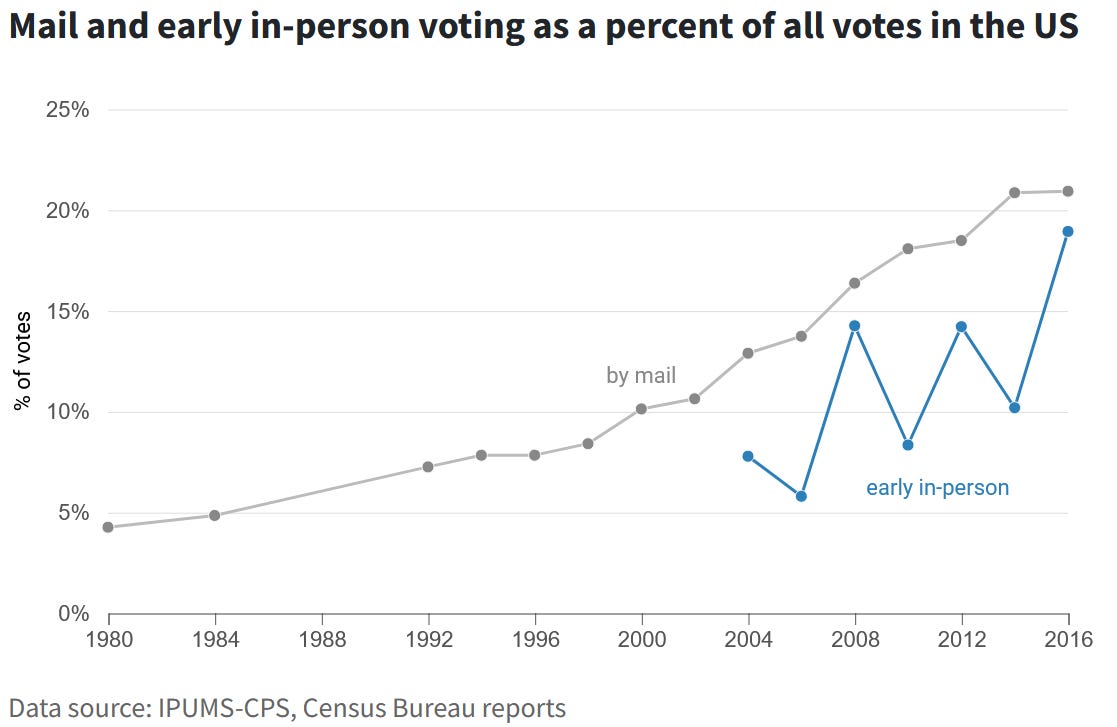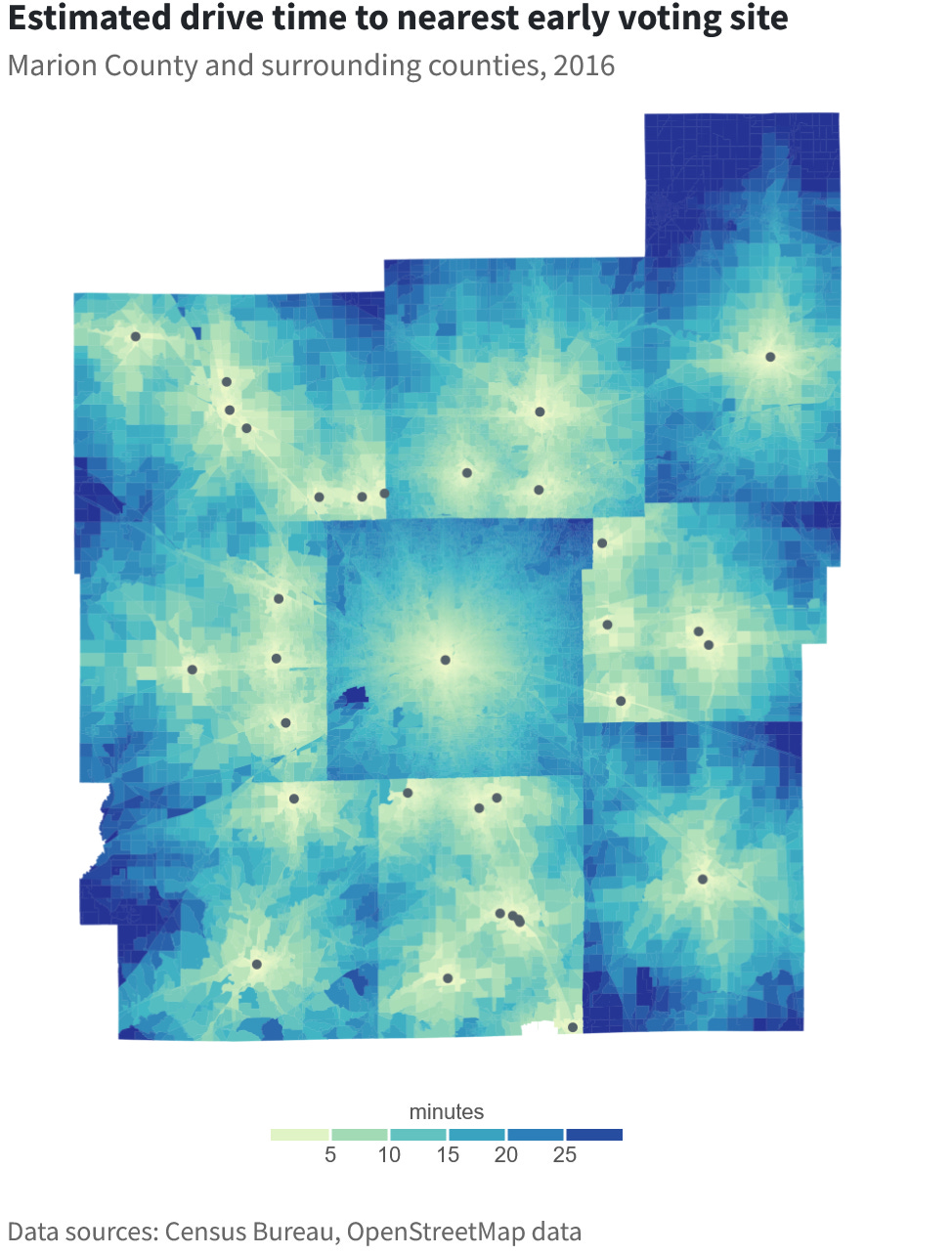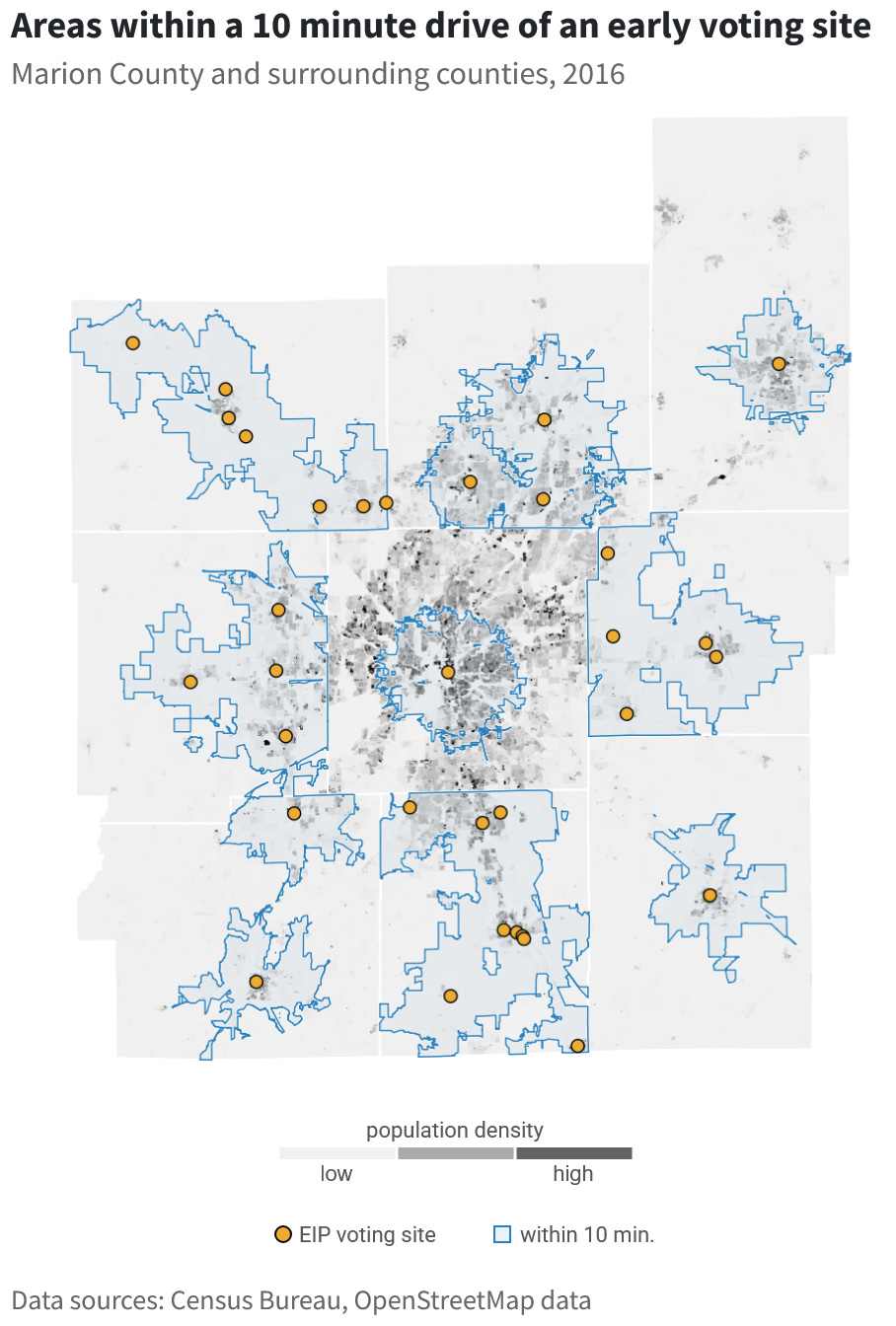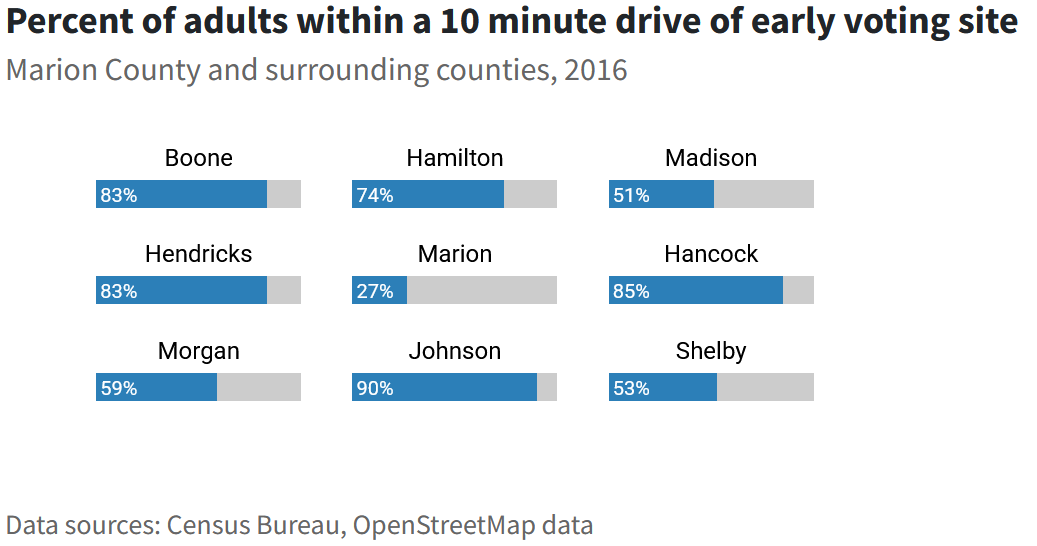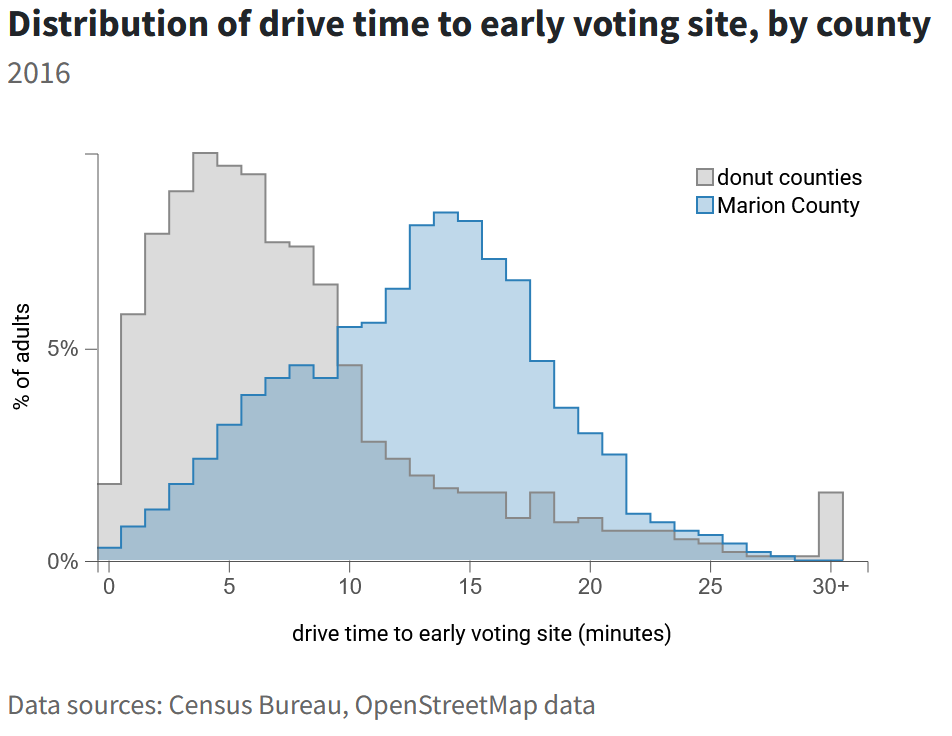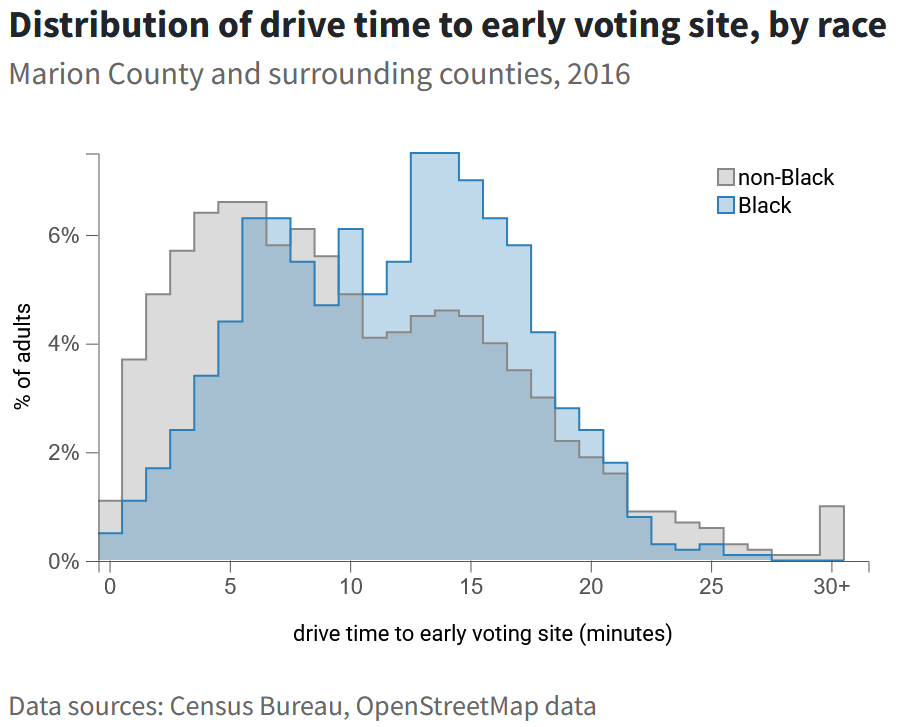
In Marion County, early voting is difficult by design
A decade-long Republican scheme prevents Marion County voters from having the same access to early voting as suburban voters.
The percentage of US voters who cast their vote before election day has increased dramatically over the past few decades. A large part of this trend is the growing popularity of early in-person (EIP) voting that takes place in the weeks prior to election day, which nearly matched the number of mail-in absentee votes in 2016.
In recent elections, many Indiana counties have increased the number of early voting sites to better accomodate voters. But since 2008, Marion County has done the opposite, eliminating its satellite locations and leaving only one central location—the City-County Building in downtown Indianapolis. The sole reason that Indiana's largest county lacks the options available to voters in other counties is that, since 2010, the single Republican member of the Marion County Election Board has blocked the resolution to add more early voting locations. In 2016, that member was Maura Hoff.
Hoff made several odd remarks in her attempts to explain her reasons for blocking the additional sites. She claimed that EIP voting is confusing to voters and that it is "not actually voting." She then opined that "an absentee ballot can be filled out at your home, which is even more convenient," so that EIP voting is not necessary (one might wonder why 19% of voters in the US chose this less convenient option in 2016).
Now, the county faces a lawsuit alleging violations of the First and Fourteenth Amendments, as well as the Voting Rights Act. Last month, a US District Court granted a preliminary injunction requiring that the county open two additional early voting locations for the 2018 general election. Because of the potential impact of the Election Board's decision on voters' First and Fourteenth Amendment rights, the court wanted to see a "legitimate, neutral justification" for its action. The court rejected every one of Hoff's explanations, calling them not credible, and even suggesting that it was Hoff herself who was confused about the nature of EIP voting. Ultimately, the court characterized her vote as entirely driven by partisanship, citing the county's tendency to vote for Democrats, as well as the fact that low-income and African-American voters disproportionately choose EIP voting when it is available.
How much did it matter?
So how significant was the lack of access to early voting in Marion County in 2016? Determining the impact on voter turnout is not an easy task. Many factors, such as geographic variation in voter behavior and variation in candidates and competitiveness across elections, make it difficult to accurately identify the effect of a particular policy or practice. Instead, this article focuses on a simple measure of access to early voting: How much time does it take a person to drive to an early voting location?
But you can't evaluate the adequacy of a early voting options without one key factor: Where people live. Plotting a ten minute drive time radius on top of a map of population density underscores the inadequacy of Marion County's single early voting center for serving its large population.
Marion County stands out as the only county where the less than half (27%) of the voting-age population is within a 10 minute drive of an early voting center. In the donut counties, 74% of potential voters were within 10 minutes of an early voting site. This does not account for traffic and parking, which are both likely to be a greater hindrance in downtown Indianapolis than at voting locations in the surrounding counties. It also doesn't account for the fact that use of public transit and lack of access to a vehicle tend to be higher in Marion County.
The distribution of drive time to an early voting location is drastically different in Marion County, compared to the surrounding counties. In Marion County, the median drive time to the early voting location was 13 minutes. The drive time for those in surrounding counties was just 6 minutes.
Given the history of voter suppression in the United States, it remains important to ask whether this partisan attempt to reduce voting access also has a disparate impact on Black voters. In this case, the answer seems to be yes. For Black adults in the 9 counties—87% of whom live in Marion County—the median travel time to an early voting site was 12 minutes, compared to 9 minutes for non-Black adults.
So why does this matter? A difference in drive time of 3-7 minutes doesn't seem like a huge inconvenience for a single person, but when you impose that on a county of nearly 700,000 potential voters, the effects can be significant. Beyond that, one would have to be naive to believe that the Republican Party just happened to oppose expansion of early voting in the only county in the region that was consistently voting for Democrats. Blocking additional early voting sites in Marion County was nothing more than a brazen attempt to deny its residents the same access to convenient voting options that were being introduced in the surrounding counties.
Are two more sites enough?
The court has ordered two additional early voting sites to be opened in Marion County for the 2018 general election. But how much will that help? This can be estimated by recalculating the drive times for Marion County with two additional locations in Marion County: One at North Central High School and another at the Southport City Clerk's office. These are the two "satellite" early voting sites that were used in 2008. With these new voting sites, 45% of potential voters live within a 10 minute drive, up from 27%. The median drive time for Black voters comes down to 11 minutes, while the median for non-Black voters also drops to 8 minutes.
Does reducing access to early voting actually affect turnout?
The growth of early in-person voting is recent, so there isn't a long history of studies on its effects. Initial research on turnout effects suggested mixed results, with some studies finding positive effects, and at least one finding negative effects.
But one of the best-designed studies on the effects of early voting is a March 2018 paper that analyzes the impact of a law that standardized early voting hours across the entire state of Ohio in 2012. The law's effects on early voting hours differed by county. The study exploits this by using voter registration data to compare the behavior of voters who live within a mile of county borders where the law changed the availability of early voting. They find that increases in early voting access lead to substantial increases in voter turnout.
Note: Sources of 2016 early voting locations include Indiana GOP and Indiana Business Journal. Drive times are calculated using the GraphHopper routing library.




